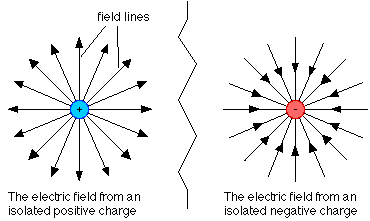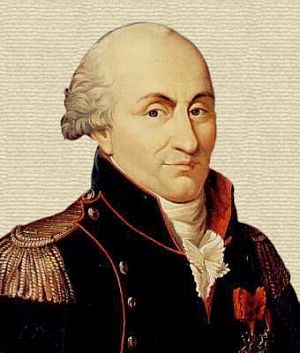Point Charge: Difference between revisions
No edit summary |
|||
| Line 4: | Line 4: | ||
==The Main Idea== | ==The Main Idea== | ||
A point charge refers to any particle that has a significantly small radius relative to the distance between it and any observation point of interest. This allows the generalization that all of the particle's charge and mass are localized at a specific point. The two known elementary charges are the proton and electron, both of which are modeled as point charges. A single proton holds a charge of +e (1.6e-19C), while an electron holds a charge of -e (-1.6e-19C). | A point charge refers to any particle that has a significantly small radius relative to the distance between it and any observation point of interest. This allows the generalization that all of the particle's charge and mass are localized at a specific point in space. The two known elementary charges are the proton and electron, both of which are modeled as point charges. A single proton holds a charge of +e (1.6e-19C), while an electron holds a charge of -e (-1.6e-19C). | ||
Every charge creates its own electric field. As shown below, the electric field of a positive point charge points radially outward and that of a negative point charge points radially inward. | Every charge creates its own electric field. As shown below, the electric field of a positive point charge points radially outward and that of a negative point charge points radially inward. | ||
Revision as of 18:28, 24 November 2018
This page is all about the Electric Field due to a Point Charge.CLAIMED BY Sindhu Kannappan 11-22-2018 (Fall 2018)
The Main Idea
A point charge refers to any particle that has a significantly small radius relative to the distance between it and any observation point of interest. This allows the generalization that all of the particle's charge and mass are localized at a specific point in space. The two known elementary charges are the proton and electron, both of which are modeled as point charges. A single proton holds a charge of +e (1.6e-19C), while an electron holds a charge of -e (-1.6e-19C).
Every charge creates its own electric field. As shown below, the electric field of a positive point charge points radially outward and that of a negative point charge points radially inward.
The field is calculated using Coulomb's Law. Indeed, the electric field is defined as a vector field that associates each point in space with the electric force that an infinitesimal test charge would experience. The source of the electric field in this article is the point charge.
A Mathematical Model of Electric Field due to Point Charge
The Electric Field of a Point Charge can be found by using the following formula:
[math]\displaystyle{ \vec E=\frac{1}{4 \pi \epsilon_0 } \frac{q}{r^2} \hat r }[/math]
Which is derived from Gauss's Law, modelling the point charge as a sphere.
[math]\displaystyle{ {\epsilon_0} }[/math] is a constant representing vacuum permittivity, the permittivity of free space, or the electric constant, and is approximately [math]\displaystyle{ 8.854*10^{-12}\frac{C^2}{N m^2} }[/math]
[math]\displaystyle{ \frac{1}{4 \pi \epsilon_0 } }[/math] is known as Coulomb's Constant and is approximately [math]\displaystyle{ 8.987*10^{9}\frac{N m^2}{C^2} }[/math]
r is the magnitude of the distance between the observation location and the source location , q is the charge of the particle and [math]\displaystyle{ \hat r }[/math] is the unit vector in the direction of the distance from the source location to the observation point.
The force on a given test charge is governed by [math]\displaystyle{ F = Eq }[/math] where E is the electric field and q is the charge of a test charge in Coulombs. This can be represented by Coulomb's Law:
[math]\displaystyle{ F = \frac{1}{4 \pi \epsilon_0 } \frac{q_1 q_2}{r^2} \hat r }[/math]
By solving for the electric field in [math]\displaystyle{ F = Eq }[/math] modeled as Coulomb's Law, one obtains the equation for the electric field of the point charge:
[math]\displaystyle{ E = \frac{F}{q_2} = \frac{1}{4 \pi \epsilon_0 } \frac{q_1}{r^2} \hat r }[/math]
A Computational Model
Below is a link to some code which can help visualize the Electric Field due to a proton.
https://trinket.io/glowscript/725d552305
Notice how the arrows grow by a factor of [math]\displaystyle{ \frac{1}{r^{2}} }[/math] as the observation location gets closer to the proton.
Examples
Simple
There is an electron at the origin. Calculate the electric field at (4,-3,1)m.
Step 1: Find [math]\displaystyle{ \hat r }[/math]
Find [math]\displaystyle{ \vec r_{obs} - \vec r_{electron} ((4,-3,1) - (0,0,0) = \lt 4,-3,1\gt }[/math]m
Calculate the magnitude of [math]\displaystyle{ \vec r }[/math]. ([math]\displaystyle{ \sqrt{4^2+(-3)^2+1^2}=\sqrt{26} }[/math]
From [math]\displaystyle{ \vec r }[/math], find the unit vector [math]\displaystyle{ \hat{r}. }[/math] [math]\displaystyle{ \lt \frac{4}{\sqrt{26}},\frac{-3}{\sqrt{26}},\frac{1}{\sqrt{26}}\gt }[/math]
Step 2: Find the magnitude of the Electric Field
[math]\displaystyle{ E_{mag}= \frac{1}{4 \pi \epsilon_0 } \frac{q}{r^2} = \frac{1}{4 \pi \epsilon_0 } \frac{-1.6 * 10^{-19}}{26} }[/math]
Step 3: Multiply the magnitude of the Electric Field by [math]\displaystyle{ \hat{r} }[/math] to find the Electric Field
[math]\displaystyle{ E = \frac{1}{4 \pi \epsilon_0 } \frac{-1.6 * 10^{-19}}{26}*\lt \frac{4}{\sqrt{26}},\frac{-3}{\sqrt{26}},\frac{1}{\sqrt{26}}\gt = \lt -4.34*10^{-11},3.26*10^{-11},-1.09*10^{-11}\gt N/C }[/math]
Middling
A particle of unknown charge is located at (-0.21, 0.02, 0.11) m. Its electric field at point (-0.02, 0.31, 0.28) m is [math]\displaystyle{ \lt 0.124, 0.188, 0.109\gt }[/math] N/C. Find the magnitude and sign of the particle's charge.
Given both an observation location and a source location, one can find both r and [math]\displaystyle{ \hat{r} }[/math] Given the value of the electric field, one can also find the magnitude of the electric field. Then, using the equation for the magnitude of electric field of a point charge,[math]\displaystyle{ E_{mag}= \frac{1}{4 \pi \epsilon_0 } \frac{q}{r^2} }[/math] one can find the magnitude and sign of the charge.
Step 1: Find [math]\displaystyle{ \vec r_{obs} - \vec r_{particle} }[/math].
[math]\displaystyle{ \vec r = (-0.02,0.31,0.28) m - (-0.21,0.02,0.11) m = \lt 0.19,0.29,0.17\gt m }[/math]
To find [math]\displaystyle{ \vec r_{mag} }[/math], find the magnitude of [math]\displaystyle{ \lt 0.19,0.29,0.17\gt }[/math]
[math]\displaystyle{ \sqrt{0.19^2+0.29^2+0.17^2}=\sqrt{0.1491}= 0.39 }[/math]
Step 2: Find the magnitude of the Electric Field
[math]\displaystyle{ E= \lt 0.124, 0.188, 0.109\gt N/C }[/math]
[math]\displaystyle{ E_{mag} = (\sqrt{0.124^2+0.188^2+0.109^2}=\sqrt{0.0626}=0.25 }[/math]
Step 3: Find q by rearranging the equation for [math]\displaystyle{ E_{mag} }[/math]
[math]\displaystyle{ E_{mag}= \frac{1}{4 \pi \epsilon_0 } \frac{q}{r^2} }[/math]
By rearranging this equation we get
[math]\displaystyle{ q= {4 pi * epsilon_0 } *{r^2}*E_{mag} }[/math]
[math]\displaystyle{ q= {1/(9*10^9)} *{0.39^2}*0.25 }[/math]
[math]\displaystyle{ q= + 4.3*10^{-12} C }[/math]
Difficult
The electric force on a -2mC particle at a location (3.98 , 3.98 , 3.98) m due to a particle at the origin is [math]\displaystyle{ \lt -5.5*10^{3} , -5.5*10^{3}, -5.5*10^{3}\gt }[/math] N. What is the charge on the particle at the origin?
Given the force and charge on the particle, one can calculate the surrounding electric field. With this variable found, this problem becomes much like the last one.
[math]\displaystyle{ E_{mag}= \frac{1}{4 \pi \epsilon_0 } \frac{q}{r_{mag}^2} }[/math]
to find the rmag value. To find [math]\displaystyle{ \hat r }[/math] we can find the direction of the electric field as that is obviously going to be in the same direction as [math]\displaystyle{ \hat r }[/math]. Then, once we find [math]\displaystyle{ \hat r }[/math], all that is left to do is multiply [math]\displaystyle{ \hat r }[/math] by rmag and that will give us the [math]\displaystyle{ r }[/math] vector. We can then find the location of the particle as we know [math]\displaystyle{ r=r_{observation}-r_{particle} }[/math]
Step 1: Find the magnitude of the Electric field.
[math]\displaystyle{ F = Eq }[/math]
[math]\displaystyle{ \lt 5.5*10^{3}, -7.6*10^{3}, 0\gt = E * -2mC }[/math]
[math]\displaystyle{ E = \frac{\lt -5.5*10^{3} , -5.5*10^{3}, -5.5*10^{3}\gt }{-2mC} = \lt 2.75*10^{6} , 2.75*10^{6} , 2.75*10^{6}\gt }[/math] N/C
Step 2:: Find [math]\displaystyle{ \vec r_{obs} - \vec r_{particle} }[/math].
[math]\displaystyle{ \vec r = (3.98 , 3.98 , 3.98) m - (0 , 0 , 0) m = \lt 3.98 , 3.98 , 3.98\gt m }[/math]
To find [math]\displaystyle{ \vec r_{mag} }[/math], find the magnitude of [math]\displaystyle{ \lt 3.98 , 3.98 , 3.98\gt }[/math]
[math]\displaystyle{ \sqrt{3.98^2+3.98^2+3.98^2}=\sqrt{47.52}= 6.9 }[/math]
Step 3: Find the magnitude of the Electric Field
[math]\displaystyle{ E= \lt 2.75*10^{6} , 2.75*10^{6} , 2.75*10^{6}\gt }[/math] N/C
[math]\displaystyle{ E_{mag} = (\sqrt{(2.75*10^{6})^2+2.75*10^{6})^2+2.75*10^{6})^2}=\sqrt{2.27*10^{13}}=4.76*10^{6} }[/math]
Step 4: Find q by rearranging the equation for [math]\displaystyle{ E_{mag} }[/math]
[math]\displaystyle{ E_{mag}= \frac{1}{4 \pi \epsilon_0 } \frac{q}{r^2} }[/math]
By rearranging this equation we get
[math]\displaystyle{ q= {4 pi * epsilon_0 } *{r^2}*E_{mag} }[/math]
[math]\displaystyle{ q= {1/(9*10^9)} *{6.9^{2}}*4.76*10^{6} }[/math]
[math]\displaystyle{ q= + 0.253 C }[/math]
Connectedness
1.How is this topic connected to something that you are interested in?
This topic is the most very basic aspect of physics relating to electricity and magnetism. As someone who is very interested in physics, this topic is important to understanding how more complex ideas that come in later on chapters work.
2.How is it connected to your major?
As a mechanical engineer, static charges don't relate to what I do all that much, but the vector algebra certainly does.
3.Is there an interesting industrial application?
The electric field of a point particle and the Superposition Principle are integral in understanding the interactions of many charges in various situations, such as a charged sphere or rod. Understanding the way charges behave is important in working with electricity.
History
Charles de Coulomb was born in June 14, 1736 in central France. He spent much of his early life in the military and was placed in regions throughout the world. He only began to do scientific experiments out of curiously on his military expeditions. However, when controversy arrived with him and the French bureaucracy coupled with the French Revolution, Coulomb had to leave France and thus really began his scientific career.
Between 1785 and 1791, de Coulomb wrote several key papers centered around multiple relations of electricity and magnetism. This helped him develop the principle known as Coulomb's Law, which confirmed that the force between two electrical charges is directly proportional to the product of the charges and inversely proportional to the square of the distance between them. This is the same relationship that is seen in the electric field equation of a point charge.
See also
Electric Field
Electric Force
Superposition Principle
Electric Dipole
Further reading
Principles of Electrodynamics by Melvin Schwartz ISBN: 9780486134673
Electricity and Magnetism: Edition 3 , Edward M. Purcell David J. Morin
External links
Some more information : http://hyperphysics.phy-astr.gsu.edu/hbase/electric/epoint.html
http://www.physics.umd.edu/courses/Phys260/agashe/S10/notes/lecture18.pdf
References
Chabay. (2000-2018). Matter & Interactions (4th ed.). John Wiley & Sons.
PY106 Notes. (n.d.). Retrieved November 27, 2016, from http://physics.bu.edu/~duffy/py106.html
Retrieved November 28, 2016, from http://www.biography.com/people/charles-de-coulomb-9259075#controversy-and-absolution

